ALMA NRAO News October 2006
ALMA News from the October 2006 Issue of the NRAO Newsletter
ATACAMA LARGE MILLIMETER ARRAY
Initial Observations with an ALMA Band 6 Mixer-Preamp: Exciting Prospects for the Future
During the past spring, spectral-line observations were conducted using a new receiver containing an ALMA Band 6 (211-275 GHz) mixer/preamp with the Submillimeter Telescope (SMT) of the Arizona Radio Observatory (ARO) at the University of Arizona. This project was a collaboration between the Central Development Lab of NRAO, Art Lichtenberger of the University of Virginia, and the ARO. The motivation behind these measurements was to evaluate ALMA technology and characterize mixer performance with real astronomical observations. The results of these tests were quite impressive, with record-breaking, single-sideband system temperatures and exceptional baseline stability over wide IF bandwidths.
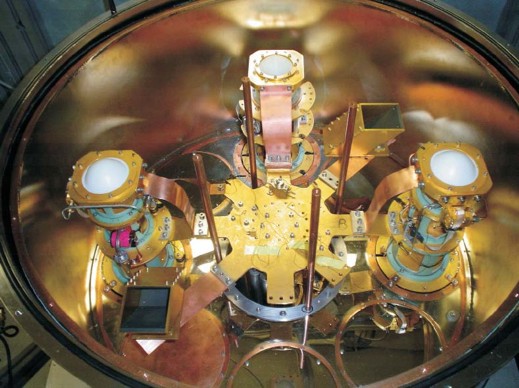 |
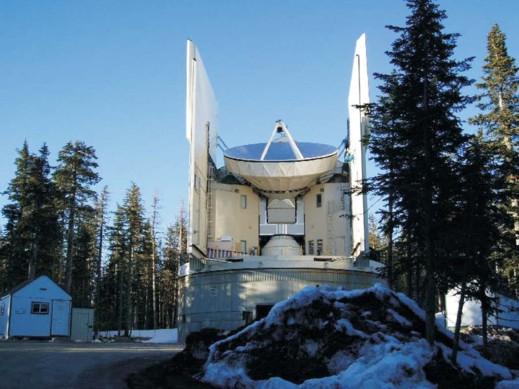 |
| Figure 1. The ALMA mixer preamp mounted in an insert in the SMT 1.2 mm Dewar. The insert is at the 12 o'clock position. | Figure 2. The SMT facility, located on Mt. Graham, AZ, was used for the ALMA tests: elevation 10,543 ft. |
To conduct these measurements, an ALMA Band 6 mixer-preamp was integrated into an insert at the ARO receiver lab and installed in the current 1.3 mm receiver Dewar at the SMT, as shown in Figure 1. The Dewar design at the SMT is similar to that used in the NRAO 12 m receivers, with insert positions arranged in a radial pattern. The insert with the ALMA components can be seen at the 12 o'clock position; two older 1.3 mm inserts are also visible in the Dewar. Although only a single polarization can be obtained from the one insert, the sideband-separating design of the ALMA mixer provides two IF signals: one from the upper and one from the lower sideband. The SMT spectrometer backends were configured to accommodate both sidebands simultaneously, each with an instantaneous bandwidth of about 2 GHz. The IF center frequency could also be steered in the range 5-7 GHz so that selected spectral transitions could be placed in the upper and lower sidebands. This flexibility was found to be useful for a variety of scientific programs.
The observations took place at the SMT (see Figure 2) in a series of 3- 4 day sessions beginning in February and concluding in June. During the 21 total days of observations, various scientific studies were pursued: investigations of isotopic ratios in planetary nebulae; on-the-fly mapping of giant molecular clouds; and spectroscopy of circumstellar envelopes of supergiant stars, molecular clouds and extra-galactic objects. Record-breaking system temperatures were found at numerous frequencies across the band. At 230 GHz, for example, a total calibrated system temperature on the sky of 107 K, single sideband, at an elevation of 50 degrees, was recorded in the LSB; at 53 degrees elevation, measurements at 245 GHz yielded Tsys = 105 K, single sideband, for the LSB. Typical system temperatures around 45 degrees elevation were around 120 - 140 K, SSB. Performance was consistent across the entire 211- 273 GHz range. The high sensitivity of the receiver resulted in the detection of molecular lines in our own atmosphere. The unexpected observation of ozone occurred during the standard total power calibration process. A representative calibration scan is shown in Figure 3; ozone lines appear at 247.762 GHz and 248.283 GHz. The combination of receiver sensitivity and atmospheric attenuation due to these transitions locally increased the system noise.
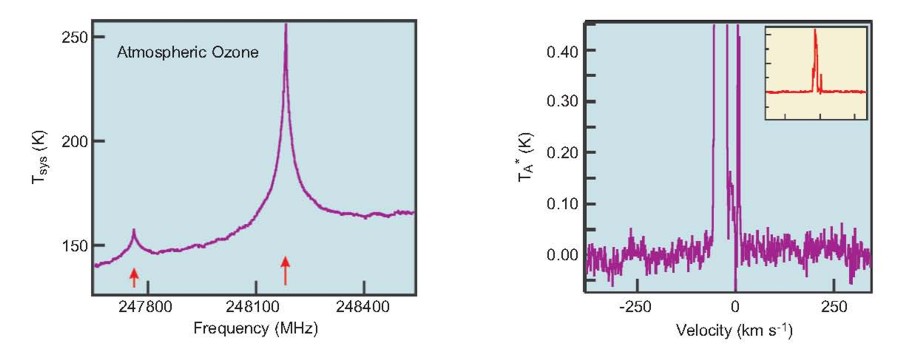
| Figure 3. A calibration scan showing two atmospheric ozone lines near 248 GHz. | Figure 4: Baseline of a 12CO, J=2-1 spectrum obtained towards the PN K3-55 in position-switching mode with a 4 degree OFF position. The integration time is 12 minutes. The full spectrum is shown as an inset in the upper left-hand corner. |
Image rejection was also excellent. Although the ALMA image rejection specification only required 10 dB, the actual values were typically greater than 20 dB in the LSB and greater than 15 dB in the USB. Simultaneous measurements of 12CO and 13CO in opposite sidebands showed that the image rejection in the LSB was greater than 22 dB at 230 GHz.
During the ALMA test time, a survey of carbon isotope ratios in planetary nebulae was initiated by Xilouris and collaborators. Most of the 29 objects studied lie well in the Galactic Plane, and therefore large offsets were required in position-switching mode to reduce the contamination from Galactic CO. Even with an off position as far away as 4 degrees in Galactic latitude, baseline stability was excellent, as shown in Figure 4. Here a raw spectrum of the CO, J=2-1 transition observed towards PN K3-55 is displayed, covering over 400 MHz with no baseline removed from the data. This survey, although at its initial stage, has more than doubled the number of PNe where a carbon isotope ratio has been measured. Preliminary results indicate severe 13C depletion, supporting the idea that at the end of stellar evolution, standard nucleosynthesis fails to match the observations. In particular, for low mass stars, non-standard mixing mechanisms need to be invoked.

Equally remarkable were data obtained in a spectral-survey of SgrB2(N), a dense cloud core, by Apponi, Ziurys, and students. Spectra were taken with almost 2 GHz of total bandwidth per IF channel. Figure 5 shows a single-sideband spectrum at 246 GHz obtained in position-switching mode with a 30 arc-minute offset in azimuth. Despite the relatively short integration time of 30 minutes, the spectral density is extremely high. Rejection of the image sideband was greater than 99 percent at this frequency, and therefore virtually every feature present in these data is in the signal sideband.
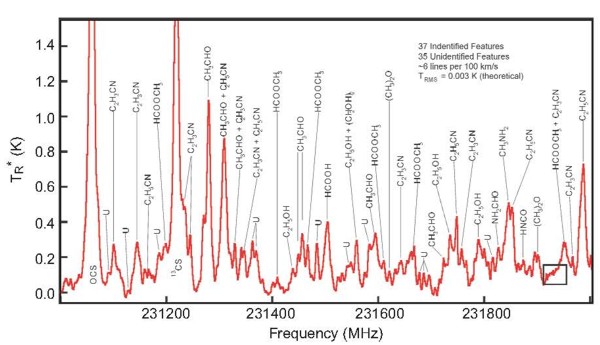
Figure 6. Confusion-limited spectrum obtained towards SgrB2(N) in 2 hours of total integration time. The image rejection is >20 dB and the large number of distinct features arise from the signal sideband-not all are marked. The actual noise level is indicated by the box on the lower right.
A more detailed spectrum is shown in Figure 6. Here a sample of the survey is shown at 231.5 GHz, covering 1 GHz in frequency. The spectral-line confusion limit has been reached in these data after two hours of integration, and the noise level can be seen only in a small section of the spectrum at the right hand corner. The spectrum in fact is so congested that not all real spectral features are labeled on the plot. About 72 individual lines are present, half which are unidentified. Once again, the image rejection is better than 20 dB. These data are about a factor of ten more sensitive than any other current 1 mm spectral-line surveys. Obtaining confusion-limited spectra with high image rejection is the absolute best that can be achieved in this source. Analysis of this survey will prove definitively which complex species are actually present in this object.Other surprising results were obtained with the new ALMA 1 mm system. A spectral survey of the oxygen-rich supergiant VY Canis Majoris was begun by Woolf, Milam, Apponi and Ziurys. In only a few days observing time, this study revealed that the envelope of this star has a chemistry far more complex than previously thought. An amazing array of interesting molecules was detected, including NaCl, PN and HCO+. CN, HNC, HCN, and CS were also found- strong evidence that CO does not control the carbon chemistry in this source. On-the-fly (OTF) observations were made of the W3 and W51 giant molecular clouds by Peters and Bieging. The receiver was tuned to place the J=2-1 transition of 12CO in the upper sideband and that of the 13CO in the lower sideband, with good image rejection in both sidebands. A region 0.42 square degrees was mapped in W3 and 0.33 in W51, with high quality spectra in both cases.
More observations will be conducted with this receiver in the fall. However, these preliminary results have already demonstrated the superior quality of the ALMA Band 6 mixer-preamp. (A more complete description of the technical aspects of the test receiver can be found in ALMA Memo #553.) The extremely good sensitivity of the Band 6 system, coupled with the high stability, bodes well for the future. The data obtained here are an exciting prelude to the wonderful science that will emerge from ALMA at 1 mm.
Lucy M. Ziurys and the ARO Staff
ALMA Construction
Amendment #2 to the Agreement Concerning the Construction of the Enhanced Atacama Large Millimeter/Submillimeter Array (ALMA) between ESO, NSF and the National Institutes of Natural Sciences of Japan has been executed by all of the parties. We welcome our East Asian colleagues to ALMA, now enhanced in both capability and name.
Progress continues toward the completion of interior finish on the 16,570 foot altitude Array Operation Site (AOS) Technical Building (TB). After the Santiago ALMA Board meeting in June, Board members visited the building and the nearby Site Characterization facility as well as the site of the center of the ALMA array. Interior finish is underway in the building, which will hold the ALMA correlators and other electronics. The Integrated Project Schedule calls for completion at the end of March 2007, and this work is on schedule. One quadrant of the correlator has been under operation at the NRAO Technology Center (NTC) in Charlottesville for several months and is ready to occupy its new quarters.
The design of the road and fiber network interconnecting the AOS TB with the antennas and their foundations is progressing toward completion in the coming months. A system for interim network access to the building is in the final stages of planning; communication currently occurs through satellite phone.
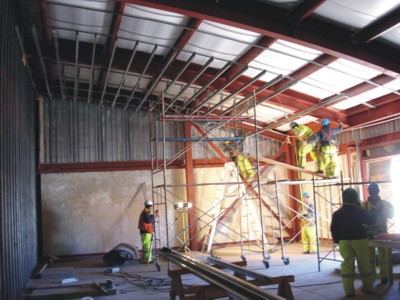
Figure 1. Work on the interior of the AOS TB has continued during the austral winter. At 16,570 feet, this is the highest technical building in the world.
Nearby on the high site, the Atacama Pathfinder Experiment (APEX), equipped with a Vertex antenna very similar to the ALMA prototype antenna, continues its operations. A special issue of Astronomy and Astrophysics was published August 1, 2006 that is devoted to early science results obtained with the APEX. One highlight is the detection of the very high excitation J=13- 12 CO line at 1,496.9 GHz. The nearby [N II] emission line at 1,461.3 GHz was unsuccessfully sought toward the Orion Bar.
The 21m wide road on which the transporter will carry antennas to the AOS from the Operations Support Facility (OSF) has been open for some time. Culvert construction and other drainage improvements continue. Not far above the OSF, a small stone corral, some 50 years old, used originally to contain animals and as sleeping quarters for local Atacamenho herdmen, was discovered during construction. It has now been restored as a historical site. It was reconstructed with the help of the local indigenous people and with the advice of the original owners. The opening ceremony for the reconstructed corral was held on July 27. The Region II Governor, Marcela Hernando, attended and delivered a speech. Archaeological study of the ALMA site has been underwritten by AUI, ESO, and NAOJ. A new book, Desert Tracks or Huellas del Desierto, decribes the archaeology of the ALMA site and may be obtained on-line at http://www.nrao.cl/.
Catherine Cesarsky, Director General of ESO, signed the contract for construction of the OSF on August 3. Its contractual partners, the VVMO Consortium, have held a kickoff meeting, and OSF construction has begun. ALMA will be operated from this building. ALMA personnel live in the nearby ALMA camp, which is now at capacity. A recreation room adjacent to the dining room was finished on time and on budget. An inauguration party was held on July 4, also celebrating U.S. Independence Day.
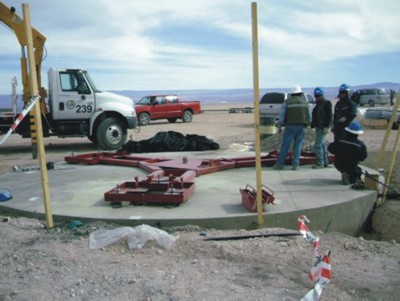
Figure 2. Bottom section of antenna jig installed and bolted to the foundation, and awaiting the first VertexRSI antenna at the OSF site.
Near the OSF at 9,600 feet elevation, the first ALMA antenna foundation has been completed. It is located at the Vertex Site Erection Facility adjacent to the future OSF. The most difficult part of an antenna foundation's construction is the installation of the steel inserts upon which each antenna is placed. Each antenna sits on a foundation supported by three precisely positioned semi-cylindrical structures. The tolerances are measured in tenths of millimeters.
To locate these properly on the foundation, the Antenna IPT has designed an installation jig, which was used on July 27 for the first time. The foundation is ready to receive the first antenna, which will be preassembled in Texas during the coming months. It arrives at the new foundation in Chile at the end of the year. The large VertexRSI Site Erection Facility building will also be constructed during the next few months.
In North America, progress continues on Prototype System Integration. The first ALMA Band 7 (270-373 GHz) receiver cartridge, shipped from IRAM in Grenoble, arrived at the North American Front End Integration Center (FEIC) at the NTC, where it joined the Band 6 (211-270 GHz) receiver cartridge constructed at the NTC (see article page 11). The Band 3 (84 -116 GHz) cartridge will soon arrive for integration at the FEIC from the Hertzberg Institute
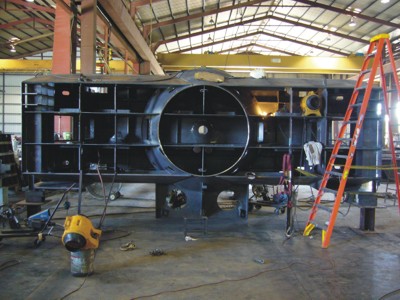
Figure 3. VertexRSI production antenna yoke base under construction in Texas, (August 23).
of Astrophysics in Victoria, Canada. The first ALMA receiver will be tested on the prototype antennas at the NRAO Very Large Array site as part of the prototype ALMA system early next year.
Scientists are keenly anticipating ALMA, which Arden Bement, Director of the National Science Foundation has called "very transformational". ALMA's prospects were the subject of a talk given by Jean Turner at the IAU General Assembly in Prague. Later in the meeting, the current status of ALMA construction was described by the ALMA Director, Massimo Tarenghi, and others at a special session The ALMA Era for Astrophysics Begins.
For the past several months, the two prototype ALMA Water Vapor Radiometers have been deployed for testing on antennas of the Smithsonian Millimeter Array on Mauna Kea. Results of these tests and others will be discussed at a Workshop on Measurement of Atmospheric Water Vapor: Theory, Techniques, Astronomical and Geodetic Applications to be held October 9-11, 2006 in Wettzell / Hoellenstein, Germany.
ALMA science topics will be the focus of a meeting Science with ALMA: A New Era for Astrophysics to be held November 13-17, 2006 in Madrid, Spain.
Attendance at the meeting was oversubscribed; about 300 persons registered. At press time, the complete schedule of scientific sessions has just been published.
Al Wootten
Transitions
The process has begun to select the Joint ALMA Office Project Scientist (JAO PS) in Santiago, Chile. The JAO PS will lead the commissioning of ALMA. Until this position is filled, the regional project scientists will continue to rotate through the JAO in Santiago on four month terms. On September 1, 2006, Al Wootten (NRAO) assumed the post from Ryohei Kawabe (NAOJ).
Jody Bolyard has recently spent a year in Santiago working for the JAO, helping document ALMA safety policies and procedures. Although he has now returned to his duties at NRAO, Jody will continue to spend 20 percent of his time as ALMA System Safety Manager.
Mauricio Pilleux, ALMA/NA Chilean Business Manager, is relocating to Charlottesville for a period of three years to lead a special project that will implement supply chain management for ALMA NA. He will continue to be the Chilean Business Manager and will be supported in Chile by the staff there.
Jonathan Williams of the Institute for Astronomy at the University of Hawaii was appointed as the new ALMA North American Science Advisory Committee (ANASAC) Chair. Jonathan has been enlisted to organize ANASAC input into key U.S. community issues, such as the upcoming general review of the North American ALMA Operations Plan.
Al Wootten
The North American ALMA Science Center (NAASC)
The primary activities at the NAASC have centered on two key documents: (1) the global ALMA operations plan, and (2) the NSF proposal for North American ALMA operations funding. NAASC staff have been working closely with the Joint ALMA Observatory and the other Executives to revise the ALMA operations plan to include the addition of Japan to the project, to account for changes arising from the project rebaseling, and to update values based on regional costs. In parallel, we have been revising the NAASC operations plan in preparation for a proposal to the NSF for North America's portion of ALMA operations funding. The ANASAC has been incorporated into the process, providing key input on community related issues such as development funding and a user grants program. The Canadian role in ALMA operations, and in developing the operations plan, has been the subject of a number of telecons and a face-to-face meeting in Tucson in early August. Both the revised ALMA operations plan and the NAASC operations plan are to be delivered to the ALMA Board and the NSF, respectively, prior to the ALMA Board meeting in November.
Beyond the work on the operations plan, the NAASC staff is busy supporting ALMA software testing and archive planning. The NAASC participated in a test of the ALMA Observing Tool in August, and will participate in tests of the Pipeline and Offline systems in December. Work continues on a NAASC-supported Spectral Line Catalogue ("Splatalogue"), and we anticipate a public release in the near future. Details should follow in the next issue of the NRAO Newsletter. Finally, planning for the second NAASC Science Workshop is well along, with a theme of protostellar and protoplanetary disks, to be held in June, 2007 in Charlottesville (see article on next page).
C. L. Carilli and J. E. Hibbard
Second NAASC ALMA Science Workshop:
Transformational Science with ALMA: Through Disks to Stars and Planets
On June 22-24, 2007, the NRAO North American ALMA Science Center and the University of Virginia will sponsor a workshop in Charlottesville, Virginia on protostellar disks. The focus of the meeting will be to discuss how ALMA will impact our understanding in several key areas of disk formation and evolution including:
- Cores, Fragmentation and the Earliest Observable Stages of Protostellar Disks
- The Disk-Envelope-Outflow Connection
- Low and High Mass Disk Structure
- Disk Chemistry, Kinematics, Isotopic Anomalies, Grain Growth, and Sedimentation
- Flaring, Spiral Density Waves, Turbulence, Magnetic Fields in Protostellar Disks
- Debris Disks Planet Formation: Fragmentation and Gaps
- Synergy between ALMA and Upcoming Optical, Infrared, and Radio Facilities.
The members of the Scientific Organizing Committee are John Bally (University of Colorado), Crystal Brogan (Chair, NRAO), Masa Hayashi (NAOJ), Michiel Hogerheijde (Leiden University), Doug Johnstone (HIA), Zhi-Yun Li (University of Virginia), Lee Mundy (University of Maryland), Jonathan Williams (University of Hawaii), and Al Wootten (NRAO). The first announcement and other information are available at http:// www.cv.nrao.edu/naasc/disk07. It is our hope that the meeting will generate extensive discussion and new ideas regarding how ALMA may be used to transform the subjects of protostellar and protoplanetary disks through presentations on the current state of our understanding, predictive theories, as well as simulations. To solicit talks on the most cutting-edge research, we will be requesting proposals for specific presentation topics in the near future. Students are especially encouraged to attend. Please bookmark our meeting page, and visit often for updates-we will be open for abstract submission soon!
Crystal L. Brogan




Connect with NRAO